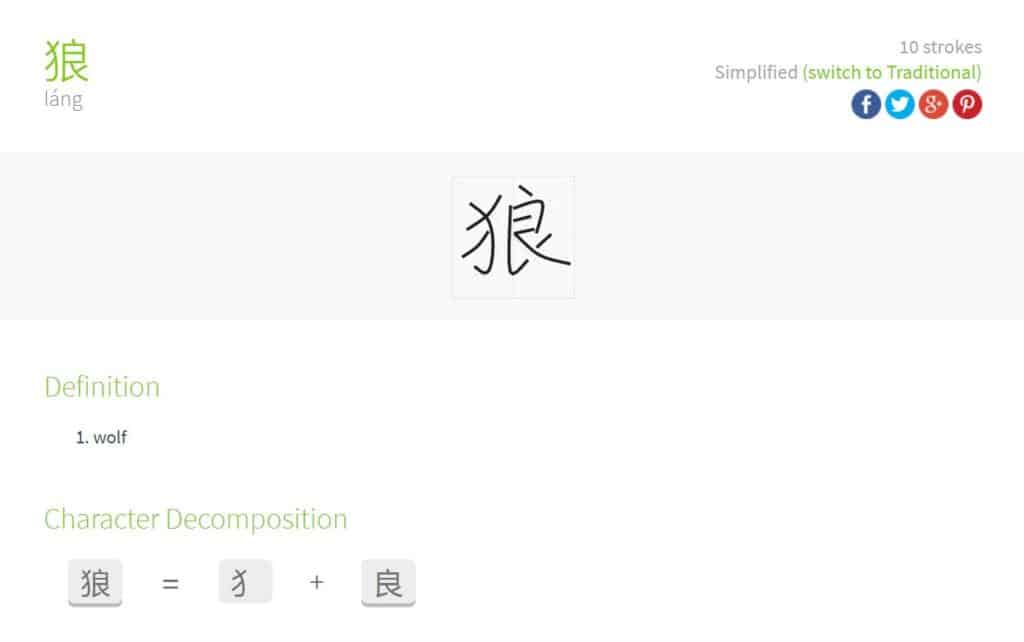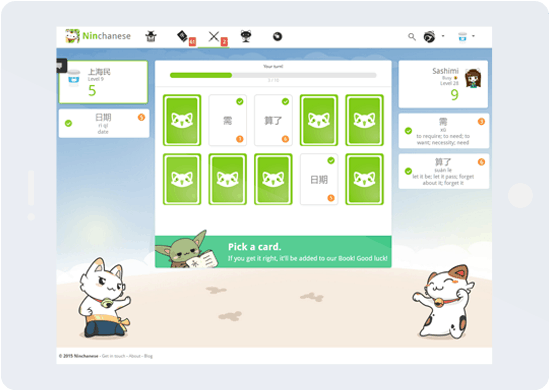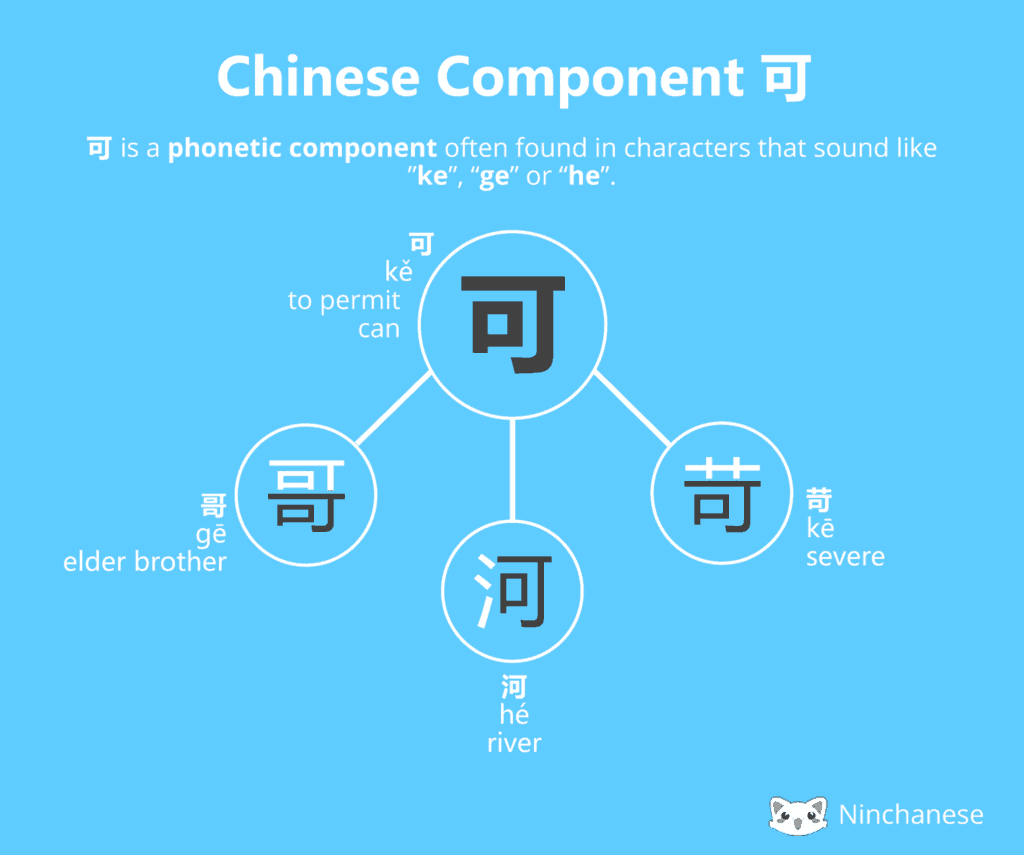How do the Chinese read aloud unknown characters? That’s something we’ve all wondered once. What if we told you there was a trick that could help you guess the pronunciation of any character you run into? Read on to unlock the secret to pronouncing 80% of all Chinese characters: phonetic components and you’ll be able to pronounce any Chinese character you meet, whether it’s on a street sign or on a restaurant menu!

With Western languages, even though you don’t know what a “flitterWochen” is (it’s an English word), you can easily read it out loud. Unlike English or Spanish, or any roman alphabet based language, in Chinese, however, it’s not that easy to read characters aloud you don’t know. The Chinese language is not a phonetic language, and with over 80,000 characters in the Chinese language, it’s quite normal to run into a character you’ve never seen before and to be at a loss as to how to pronounce it. So, how do the Chinese know how to read characters they’ve never seen before?
The secret trick
At first glance, the many strokes that compose a Chinese character don’t look like they give out many hints as to how they are to be pronounced. In fact, for a long time, you were expected to connect the strokes of characters to the sounds they refer to by sheer rote memorization. But, this is no longer the case. The Chinese know something you don’t and we’re going to let you in on their big secret: Chinese characters do represent sound, thanks to phonetic components. Phonetic components are indications the character contains on its pronunciation.
🏮 Ninchanese is an incredible app for learning Chinese! 🏮
” I actually graduated from the University of Edinburgh with a MA in Chinese.
I’ve used Ninchanese daily, and it has helped me a lot! “
– Connor, Ninchanese User
Try Ninchanese, an award-winning method to learn Chinese today:
Start Learning Now
How to deal with an unknown character
When you run into an unknown character, the first thing you want to do is analyze it and break it down to see what it’s made of.
That way, rather than seeing and trying to remember a jumble of strokes, when you break down a character, you easily spot the different meaningful elements that make it up.

You can break down the characters yourself, or look at a Chinese dictionary, like Ninchanese’s. The dictionary will show you how the character can be decomposed, and allow you to look up the different elements in the character.
What can you expect to see?
Most of the time (over 80% of the time), the character you’ll be looking at will be a picto-phonetic character.
This is the most common way of forming characters. In fact, more than 80% of all Chinese characters are pictophonetic characters. That’s great news for us Chinese learners, and you’re soon going to understand why.
Picto-phonetic characters are made of two pieces, called components. These two components are usually a meaning (also known as semantic) component and a phonetic component. One piece gives you a clue to the word’s meaning, another to the word’s pronunciation. Isn’t that great? Meaning components and phonetic components really are the building blocks of the Chinese written language.
As today we’re exploring how to read out loud a character you’ve never seen before, our focus is on phonetic components. Let’s see what a phonetic component is precisely and how you can easily use it to know how a character sounds!
What are phonetic components?
Phonetic components are elements in a Chinese character that give you clues on a character’s pronunciation. They can be used to deduce the intonation of an unknown Chinese character. Curious to know how?
Let’s take the character 妈 mā mother. If you break it down, you’ll see it’s made of two parts:
女 which is a meaning component, symbolizing femininity, and 马, which is pronounced mǎ (and when used as a standalone character, means horse). As you can see, 妈’s sound matches the component 马’s pronunciation, aside from the tone. Here, 马 is a phonetic component.
Now that you know 马 is a phonetic component, can you pronounce: 吗, 骂, and 码?
That’s right, they’re all pronounced “ma”. Well done! You can expect Chinese characters that contain this phonetic component to sound the same.

In most of the cases, when you identify a phonetic component in a character, the character will be pronounced either exactly like the component or have a sound pretty close to it.
How to spot a phonetic component in a Chinese character
So you have your Chinese character in front of you. You may be wondering: is there an easy way to spot which part of the character is the phonetic component
The Chinese like to say:
有边念边,没边念中间吗,没有中间,自己编.
However, this method doesn’t always work. The phonetic component can indeed often be found on the right side of a character.
But, it’s also common for the phonetic component to be below the meaning component.
In other character structures, you’ll find the phonetic information inside another element; and, even more rarely, in other combinations.
When in doubt, go to your favorite online Chinese dictionary, and look up the character. Its character decomposition will help you research which element is the phonetic component, and what the other element(s) that compose the character are.
How do you master phonetic complements?
Phonetic components have traditionally less been studied than meaning components, which is a shame, as they are tremendously useful to knowing how to read and write a Chinese character. Before teachers used to expect the students to learn how to pronounce all the characters by rote, at least, now, we know we can rely on phonetic components to read an unknown character’s pronunciation.
One thing we don’t know for sure,however, is how many phonetic components there are.
Early research on the subject, by Soothill in the 1880s for instance, listed up to 1000 phonetic components. Other researchers have suggested other numbers, ranging from less to more. It may seem like a lot, but, we have lots of good news.
First, you can start by learning the most common phonetic complements first.
Excited by the idea of mastering the essential phonetic components? Then join us every Monday in our community.
Your Monday meeting with a component
Meet the phonetic component 包! Learn how to use it, by clicking here >> https://t.co/IJ5B4a3eZ6 #chinese #learn pic.twitter.com/M7sfpI6EF9
— Ninchanese (@Ninchanese) June 27, 2016
Every Monday, on Facebook, Twitter, and Google+, get to know the key phonetic components and meaning components! You are introduced to a new component each week. You learn to use it all week in all sorts of fun activities, from silly dialogues to cool word building. Each component has a whole page dedicated to it, so you can also study in detail about it.
Head to this page to see all the Chinese character components you need to know. More are added each week! Don’t miss this weekly rendezvous.
Second, phonetic components are, more often than not, also standalone characters
This means: you’ll learn them as words, and then happily be able to spot them in words.
In addition, and that’s the second piece of good news: phonetic components tend to retain the same shape in the character they’re in. They don’t change shapes like a meaning component might do, which makes it even easier to spot them right?
Two key takeaways from this:
When you run into a new character, look for familiar elements. See if it looks anything alike the characters you already know and if it has anything in common with them. When you go to a place you’ve never been before, you look for something familiar, whether it’s a friend or an object, right?! By making an association between the characters you’ve learned before and the familiar features of the unknown character, you’ll possibly find clues on its pronunciation. For example, if you know the word 马 mǎ horse, there’s a big chance you’ll be able to pronounce words such as 吗 ma question particle or 妈 mā mother.
At Ninchanese, we know that phonetic components matter, so we help you help you learn all the components at your own pace. As you learn new words, you’ll learn and master new components so you can identify them better in unknown words. In addition to the learning stages, we also have many tricks to help you catch them all -yup, still talking about the phonetic components.
See, phonetic components come in particularly handy when you play a Ninchallenge.
Ninchallenge your knowledge!
In Ninchanese, you can engage your friends in fun battles called the Ninchallenges. Ninchallenges are the opportunity to review the Chinese words and characters you’ve learned before and learn new words while playing with your friends. They test your knowledge of Chinese. In the Ninchallenges, you mostly pick words you know but sometimes you pick unknown characters and words.

What happens, then? It’s up to you to guess their pronunciation! What are you going to need? That’s right: a phonetic component. If you know the phonetic component that is in the character you need to guess, you’ll be able to easily read them out loud and write down their pinyin.
For example, it’s your turn to play and you’re supposed to guess how to read the character 踉. You’ve never seen this character before, but that doesn’t mean all is lost. You now have your secret weapon: phonetic components!
Do you recognize a component you know in this in this character 踉? Yes, in the right-hand corner, there’s the phonetic component 良 liáng good, well-spotted! So how about taking a gamble and saying this character 踉 sounds about the same? Well done! You’re right, 踉 liáng jump sounds precisely the same, plus it’s an exact match!
Phonetic components are powerful in a Ninchallenge… and in real life
This happens in a Ninchallenge, but it will also happen to you in real life. You’ll run into all sorts of unknown character you’ll need to decipher and guess how they’re pronounced.
As you see, learning the components is essential if you want to expand your understanding of the Chinese language, and your resourcefulness when facing unknown characters.
There’s also many resources you can use to improve your knowledge of phonetic complements. For example, if you want to see all the perfect matches of the phonetic sets, Hanzicraft has an amazing database to explore.
Now you’ve got all the resources to master the phonetic components, you’re ready to pronounce an unknown Chinese character thanks to the phonetic sets. How can you use them to guess how to pronounce a character in Chinese?
What phonetic components will tell you about how to write and read Chinese characters
Great, so now you know where to look for a phonetic component in a Chinese character. Let’s move on to the indications these phonetic complements can give you on a character’s intonation.
As said before, Ninchallenges mirror the experience you’ll get in real life in a Chinese speaking country. Restaurant menus are the best example, but street signs and newspapers are also good ones to train yourself to read out loud unknown Chinese character. You’ll be often faced with unfamiliar and unknown words, but still, you have to deal with them if you want to win. So how do you overcome that obstacle? You look for clues.
Here’s an example that can happen to you in real life.
You meet the Chinese character 晴 when reading the weather forecast. The context may help understand the word, but how do you pronounce it? When you break down the character 晴 you get:
日 rì day + 青 qing green.Here, 日 brings the meaning and 青, on the right side, is a phonetic component, which brings the sound. Then, you know the character 晴 will sound like “qing”. Indeed, 晴 is pronounced qíng and means clear (sky).

Phonetics can be essential on a daily basis. For example, if you want to order food but don’t know a character on the menu, you can try to pronounce it using your phonetic component knowledge and get an explanation from the waiter. Plus, you can practice your Chinese by speaking to the waiter. It makes you speak Chinese and practice your understanding skills. Neat!
The examples we’ve shown so far are perfect or near perfect matches for the phonetic component, but is that always the case?
Do characters always sound like the phonetic component they contain?
Yes and no. There are also several kinds of matches.
Perfect matches
If a character has the same sound, pinyin, and tone as the phonetic component it contains, it’s called an exact match. The character 洋 yáng ocean, for example, is an exact match with the phonetic component 羊 yáng sheep.
Near-perfect matches
Then you can find second-degree matches. These are characters that share the same sound as the phonetic component it is made of but not the same tone.
The character 样 yàng manner is a second-degree match with the phonetic component 羊 yáng sheep as they don’t have the original tone but share the same sound.
A little more distant matches
You can also find characters that share the same phonetic component and that have different, but very close sounds. Here, the phonetic component 可 kě to permit can be found in characters that sound like “ke”, “ge” or “he”. These three pronunciations share the finals “e”. A phonetic component can have two or more possible pronunciations that share the same initials, finals or tones.

Exceptions
As you can see, phonetic components aren’t an accurate science and there are some exceptions. The Chinese language has evolved a lot over the years, and therefore, sometimes, you have to look at character etymology, the traditional forms of characters or older sounds to understand why the character is pronounced the way it is.
Despite that, knowing phonetic components is a big piece of the Chinese puzzle, and your key to being able to be able to guesstimate the pronunciation of 80% of all characters. If that’s not meowsome then I don’t know what is.
So, learn to master the different phonetic components and you’ll be able to read any character.
Final words:
If you’ve always wondered how the Chinese managed to pronounce characters they’d never seen before, now you know they owe it to the phonetic compounds. Learning them is important to find unknown words’ pronunciation and also to understand the Chinese logic and memorize the characters better.
Here’s a quick summary of what you need to remember about the phonetic components that:
- Once you master a phonetic component, you master the pronunciation of the several characters that contains it.
- Most Chinese characters are either exact and second-degree matches for the phonetic component they contain.
- A same phonetic component can lead to various pronunciations that share the same initials, finals or tones
- In short: Dare to make guesses. If you don’t find the same intonation, you’ll end up close. And that’s a great start.
- Practice guessing the sounds of unknown Chinese characters and honing your deciphering skills in the Ninchallenges.
Don’t forget our one week one component to keep learning new components! You also continue your reading about Chinese characters and check out the following post about how many characters you need to know.
By the way, for your personal acknowledge, a “flitterwochen” is an old English expression to say “honeymoon”. Good to know when playing Scrabble!
Have you experienced an obstacle when meeting an unknown character? What’s your experience deciphering unknown characters? Let us know in the comments below!






3 comments
Join the conversationPingback: Mandarin Weekly #77 – Mandarin Weekly (每周中文)
Pingback: Mandarin Weekly #77 - Startupnet
Pingback: New world: The Chinese Character Universe - Science based Chinese characters learning - Ninchanese
Comments are closed.